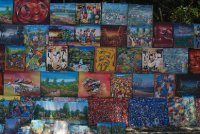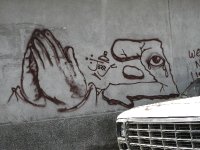Port-au-Prince
Travel Guide Caribbean Haiti Port-au-Prince
Introduction
Port-au-Prince is the capital and largest city in Haiti with a total population of about 1.1 million in the city, 1.8 million in the larger metropolitan area. It is located in the south of the country on a bay of the Gulf of Gonâve. Despite being the cultural, economic and political capital, the city is not really a focus for many travellers. Although there is a small but steady stream of visitors, the city and the country as a whole remain politically unstable and some parts of the city, especially the parts outside of the fine centre, are best avoided. The city also suffered a terrible earthquake in January of 2010 which destroyed large portions of the cities including the major infrastructure.
Neighbourhoods
- Petion-Ville - a wealthy suburb in the hills to the south of Port-au-Prince, with many restaurants, bars, hotels and shops (officially a separate town).
- Delmas
- Cite Soleil - a large area of informal settlement and slums. Previously notorious for gangs, the area is now accessible but still dangerous.
- Carrefour - a large and densely populated town to the west of Port-au-Prince (officially a separate town).
- Croix-des-Bouquets
- Bel-Air
- Santo
Sights and Activities
Shopping For Art
Painters, metal workings and wood workers are found everywhere in Haiti. The easiest place to purchase great colorful Haitian art is in Port-au-Prince. Painters hang their work all over the city hoping to sell it. Many sell similar pieces or sell paint by numbers work. However there are plenty of original pieces to be found. Remember that all pieces can be bargained and the art is very good. Since the earthquake many artists have started to incorporate images and feelings from the quake and these pieces can be very powerful.
Boutillier
At the top of the highest point of Port-au-Prince, near all the cellphone towers, is the scenic overlook of Boutillier. This wonderful view allows a visitor to see the entire city and the surrounding area. The only way to get up to this scenic overlook is by private driver and is well worth it. There are also several local artists selling their work here.
Events and Festivals
Due to the blending of Catholic and Voodoo traditions, Haiti has several vibrant holidays ranging from Independence Day celebrations to one of the most intense carnivals in the Caribbean.
- Independence Day and New Years are both on January 1st and together are considered a national holiday with joumou, a kind of pumpkin soup, being eaten as a tradition. New Year’s Day is a widely celebrated holiday across countries following the Christian calendar, but this day is also when Haiti commemorates the country’s independence. Jean-Jacques Dessalines declared the nation free from the French colonizers in 1804, making it a joyous occasion.
- Ancestors Day is on January 2nd and is a major Holiday
- Heroes Day celebrates many of Haiti's heroes and is on January 3rd.
- Carnival - Called “Kanaval” in local Creole, this event takes place annually in January or February and traditionally coincides with the start of Lent. All of Haiti comes alive as the cities are filled with colorful parades and pageants, dancing and singing. The festivities turn into night-long parties where the locals come together in celebration. Lent varies according to the Christian calendar, while Carnival takes place in the preceding weeks, concluding on Shrove Tuesday ( “Fat Tuesday”).
- Death of Toussaint Louverture celebrates the death of Haiti's founding father and is on April 4th.
- Flag Day is on May 18th and usually features parades. It is also a popular holiday for protesters against the government.
- Corpus Christi on June 3rd is important to the Catholic population of the country.
- Pilgrimage of St. D'Eau is an important religious holiday during the festival of Our Lady of Carmel from July 14–16.
- October Death of Jean-Jacques Dessalines is celebrated on July 17th.
- Battle of Vertieres is a celebration of one of the most important battles for Haitian independence on November 18th.
- Decouverte of Haiti is the celebration of Columbus discovering Haiti on December 5th. This is one of the most important holidays in Haiti
- Christmas, on December 25th, is an extremely important holiday for Haitian Christians and practicers of Voodoo.
- Rara - Rara is another festival that is linked to the Christian calendar, taking place on Easter week. There are many parades with traditional Haitian-style and Afro-Caribbean music being played. The lively atmosphere is boosted by the many percussive instruments ringing through the streets, with melodies from a bamboo trumpet-style instrument called a vaksen.
- Krik? Krak! Festival - Usually held in May, this family-oriented festival is filled with traditional storytelling of Haitian folklore. There are many other Voodoo celebrations happening throughout the year in different locations.
- Dessalines Day - Held on October 17, this holiday celebrates the death of the modern nation’s founder, Jean-Jacques Dessalines. Haitians are proud that their country became one of the first independent nations in the Americas and was the first ever republic to be led by people of African descent.
Weather
Port-au-Prince enjoys a tropical climate, with hot and humid weather for most of the year. Temperatures as well as rainfall are highest between May and November. December to April is slightly cooler but with far less rain. Temperatures are roughly around 30 °C during the day and still above 20 °C at night.
Getting There
By Plane
Toussaint Louverture International Airport (PAP) near Port-au-Prince serves a number of international destinations. Air D'Ayiti operates several flights in the Caribbean and to Miami. Other airlines have flights to New York, Montreal, Panama, the Dominican Republic, Curacao and Air France flies to Cayenne in French Guiana. The airport was heavily damaged during the airport but still in use. Remember when checking into flights there are different entrances for the different airlines. There are baggage men that can help you but you don't have to use them. They can be a bit aggressive when trying to help you and demanding a tip.
Tortugair has domestic flights between Port-au-Prince and Jacmel, Cap-Haïtien, Les Cayes and Port-de-Paix.
Getting from the airport to the city can be quite an experience. After exiting the airport travellers enter a mass of people screaming and shouting. It is best to arrange transport before hand. Most hotels offer free, or affordable, transport to and from the airport. If this is an option use it.
By Bus
Buses travel between Port-au-Prince and the main cities and towns in the country. There are also buses that ply the route to/from the Dominican Republic, all the way to Santo Domingo.
Sleep
Mid-Range
- Matthew 25 - Matthew 25 is a nice midrange guesthouse located in a good area of the city. The cost per bed is US$55 with a max of 4 people to room. Room and board include breakfast, dinner and transport to and from the airport. This is a catholic guesthouse so all rooms are single sex. Email: [email protected]. Address: Delmas 33, #6 Rue A. Martial
Work
Port-au-Prince is the epicenter for the relief effort in Haiti. Finding work with international agencies is possible it is best to arrange contacts before arriving. Another possibility is to start your own project, just remember that raising money in Haiti is very difficult.
External Links
Accommodation in Port-au-Prince
We have a comprehensive list of accommodation in Port-au-Prince searchable right here on Travellerspoint.
Contributors
 Utrecht (59%)
Utrecht (59%)
from https://utrecht.travellerspoint.com Lavafalls (31%)
Lavafalls (31%)
from Silver Drops Jewelry Designs
as well as Peter (5%), Beausoleil (3%), Hien (1%), tom.newby (1%)
Port-au-Prince Travel Helpers
We don't currently have any Travel Helpers for Port-au-Prince
This is version 21. Last edited at 18:48 on Jul 17, 20 by Beausoleil. 5 articles link to this page.

Except where otherwise noted, content of this article is licensed under a Creative Commons Attribution-ShareAlike 3.0 License




